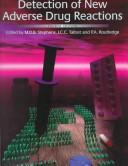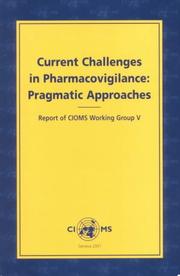| Listing 1 - 10 of 20 | << page >> |
Sort by
|

ISBN: 9780333693919 0333693914 Year: 1998 Publisher: London : Macmillan reference books,
Abstract | Keywords | Export | Availability | Bookmark
 Loading...
Loading...Choose an application
- Reference Manager
- EndNote
- RefWorks (Direct export to RefWorks)
Book
Year: 2012 Publisher: Bruxelles: UCL,
Abstract | Keywords | Export | Availability | Bookmark
 Loading...
Loading...Choose an application
- Reference Manager
- EndNote
- RefWorks (Direct export to RefWorks)
Drug Toxicity --- Adverse Drug Reaction Reporting Systems --- Pharmacists --- Pharmacovigilance
Book
ISBN: 0952664305 Year: 1996 Publisher: Cambridge European conference publications
Abstract | Keywords | Export | Availability | Bookmark
 Loading...
Loading...Choose an application
- Reference Manager
- EndNote
- RefWorks (Direct export to RefWorks)
Toxicity Tests --- Drug Monitoring --- Adverse Drug Reaction Reporting Systems --- Europe.
Book
ISBN: 2742001247 Year: 1998 Publisher: John Libbey Eurotext,
Abstract | Keywords | Export | Availability | Bookmark
 Loading...
Loading...Choose an application
- Reference Manager
- EndNote
- RefWorks (Direct export to RefWorks)
ADVERSE DRUG REACTION REPORTING SYSTEMS --- DRUG THERAPY --- DRUG INFORMATION SERVICES --- ADVERSE EFFECTS
Book
Abstract | Keywords | Export | Availability | Bookmark
 Loading...
Loading...Choose an application
- Reference Manager
- EndNote
- RefWorks (Direct export to RefWorks)
ADVERSE DRUG REACTION REPORTING SYSTEMS --- DRUG THERAPY --- DRUG INFORMATION SERVICES --- ADVERSE EFFECTS
Book
Abstract | Keywords | Export | Availability | Bookmark
 Loading...
Loading...Choose an application
- Reference Manager
- EndNote
- RefWorks (Direct export to RefWorks)
Dissertation
ISBN: 9789077113981 Year: 2009 Publisher: S.l. s.n.
Abstract | Keywords | Export | Availability | Bookmark
 Loading...
Loading...Choose an application
- Reference Manager
- EndNote
- RefWorks (Direct export to RefWorks)
Dissertation
ISBN: 9789039352595 Year: 2010 Publisher: Rotterdam Optima grafische communicatie
Abstract | Keywords | Export | Availability | Bookmark
 Loading...
Loading...Choose an application
- Reference Manager
- EndNote
- RefWorks (Direct export to RefWorks)
Drug Approval --- Orphan Drug Production --- Adverse Drug Reaction Reporting Systems --- Rare Diseases --- Research --- legislation & jurisprudence --- legislation & jurisprudence --- drug therapy

Abstract | Keywords | Export | Availability | Bookmark
 Loading...
Loading...Choose an application
- Reference Manager
- EndNote
- RefWorks (Direct export to RefWorks)
In spite of recent progress in the harmonization of terminology and processes affecting work on the clinical safety of medicines, consensus is needed on standards for many difficult aspects of day-to-day pharmacovigilance that continue to pose problems for both the pharmaceutical industry and drug regulators. The CIOMS V Working Group has generated proposals for pragmatic approaches to dealing with such issues as: classification and handling of individual safety case reports from a variety of sources (spontaneous consumer reports, solicited reports, literature, the Internet, observational studies and secondary data bases, disease and other registries, regulatory ADR databases, and licensor-licensee interactions); new approaches to case management and regulatory reporting practices (proper clinical evaluation of cases, incidental vs other events, patient and reporter "identifiability," seriousness criteria, expectedness criteria, case follow-up criteria, and the role and structure of case narratives); improvements and efficiencies in the format, content and reporting of periodic safety update reports (PSURs) (including results of an industry survey on PSUR workloads and practices; proposals for high case volume and long time-period reports, simplification of certain PSURs, summary "bridging" reports, "addendum" reports, license renewal reports for EU and Japan, dealing with "old" products, and other technical details); determination and use of population exposure (denominator) data (sources of data and a guide to analytical approaches for a variety of circumstances).The Group has also taken stock of the current state of expedited and periodic clinical safety reporting requirements around the world, with summary data on regulations from more than 60 countries. Recommendations are made for enhancing the harmonization steps already taken as a result of previous CIOMS publications and the ICH process.In addition to dealing with unfinished and unresolved issues from previous CIOMS initiatives, the report covers many emerging topics such as those involving new technologies. Its 20 Appendices provide a wealth of detailed explanations and reference information. It is the most comprehensive and recent treatment of difficult pharmacovigilance issues affecting the working practices and systems of drug safety and other pharmaceutical professionals.
QV 37.5 Drug interactions --- QV 37.5 Drug interactions --- QV 37.5 Drug interactions --- Drug Monitoring --- Drug Monitoring --- Drug Monitoring --- Drug Utilization --- Drug Utilization --- Drug Utilization --- Adverse Drug Reaction Reporting Systems --- Adverse Drug Reaction Reporting Systems --- Adverse Drug Reaction Reporting Systems --- Pharmaceutical Preparations --- Pharmaceutical Preparations --- Pharmaceutical Preparations --- Medication Errors --- Medication Errors --- Medication Errors --- Handbooks --- Handbooks --- Handbooks
Book
ISBN: 9789290360827 Year: 2010 Publisher: Geneva CIOMS
Abstract | Keywords | Export | Availability | Bookmark
 Loading...
Loading...Choose an application
- Reference Manager
- EndNote
- RefWorks (Direct export to RefWorks)
In recent years public expectations for rapid identification and prompt management of emerging drug safety issues have grown swiftly. Over a similar timeframe, the move from paper-based adverse event reporting systems to electronic capture and rapid transmission of data has resulted in the accrual of substantial datasets capable of complex analysis and querying by industry, regulators and other public health organizations.These two drivers have created a fertile environment for pharmacovigilance scientists, information technologists and statistical experts, working together, to deliver novel approaches to detect signals from these extensive and quickly growing datasets, and to manage them appropriately. In following this exciting story, this report looks at the practical consequences of these developments for pharmacovigilance practitioners. The report aims primarily to provide a comprehensive resource for those considering how to strengthen their pharmacovigilance systems and practices, and to give practical advice. But the report does not specify instant solutions. These will inevitably be situation specific and require careful consideration taking into account local needs. However, the CIOMS Working Group VIII is convinced that the combination of methods and a clear policy on the management of signals will strengthen current systems.Finally, in looking ahead, the report anticipates a number of ongoing developments, including techniques with wider applicability to other data forms than individual case reports. The ultimate test for pharmacovigilance systems is the demonstration of public health benefit and it is this test which signal detection methodologies need to meet if the expectations of all stakeholders are to be fulfilled.
Drug Utilization --- Drug Utilization --- Drug Utilization --- Drug Monitoring --- Drug Monitoring --- Drug Monitoring --- Adverse Drug Reaction Reporting Systems --- Adverse Drug Reaction Reporting Systems --- Adverse Drug Reaction Reporting Systems --- Pharmaceutical Preparations --- Pharmaceutical Preparations --- Pharmaceutical Preparations --- Handbooks --- Handbooks --- Handbooks --- Medical Errors --- Medical Errors --- Medical Errors --- Statistical methods --- Statistical methods --- Statistical methods --- QV 37.5 Drug interactions --- QV 37.5 Drug interactions --- QV 37.5 Drug interactions
| Listing 1 - 10 of 20 | << page >> |
Sort by
|

 Search
Search Feedback
Feedback About
About Help
Help News
News